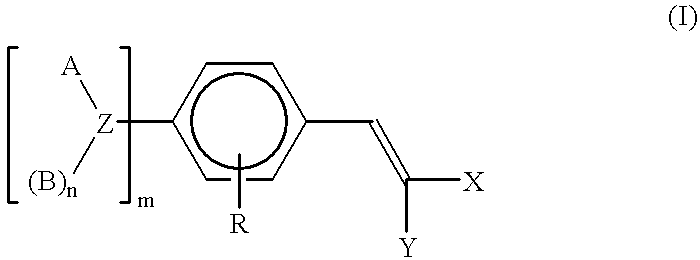Polymeric methine ultraviolet absorbers
a technology of ultraviolet absorption and polymer methacrylate, which is applied in the field of ultraviolet absorption, can solve the problems of difficult incorporation within different target media, relatively low melting point, and potentially damaging range of unprotected ultraviolet exposure, and achieve the effect of wide ultraviolet protection rang
- Summary
- Abstract
- Description
- Claims
- Application Information
AI Technical Summary
Benefits of technology
Problems solved by technology
Method used
Image
Examples
example 2
One-hundred parts of p-formyl-N,N-polyoxyethylene-polyoxypropyleneaniline (7 moles EO and 15 moles PO) were mixed with 24 parts of diethyl malonate, 4.4 parts of morpholine, and 3.3 parts of acetic acid. The mixture was then heated to between 80 and 85.degree. C. for 3 hours. The reaction was monitored by the UV-Vis spectra of the mixture. When the reaction was completed, as indicated by the presence of an absorption maximum at 377 nm (A / gl=22.0), the product was further stripped under reduced pressure to yield the final product.
example 3
Two hundred and fifty parts of p-formyl-N,N-polyoxyethylene-polyoxypropylenetoluidine (16 moles EO and 10 moles PO) were mixed with 43 parts of diethyl malonate, 7.9 parts of morpholine, and 5.7 parts of acetic acid. The mixture was then heated to between 80 and 85.degree. C. for 3 hours. The reaction was monitored by the UV-Vis spectra of the mixture. When the reaction was completed, as indicated by the presence of an absorption maximum at 383.5 nm (A / gl=17.5), the product was further stripped under reduced pressure to yield the final product.
example 4
Five hundred and twenty parts of p-formyl-N,N-polyoxyethylene-polyoxypropyleneaniline (7 moles EO and 15 moles PO) were mixed with 78 parts of ethylacetoacetate, 24 parts of morpholine, and 70 parts of acetic acid. The mixture was then heated to between 80 and 85.degree. C. for 3 hours. The reaction was monitored by the UV-Vis spectra of the mixture. When the reaction was completed, as indicated by the presence of an absorption maximum at 387.5 nm (A / gl=14.7), the product was further stripped under reduced pressure to yield the final product.
PUM
| Property | Measurement | Unit |
|---|---|---|
| wavelengths | aaaaa | aaaaa |
| wavelengths | aaaaa | aaaaa |
| wavelengths | aaaaa | aaaaa |
Abstract
Description
Claims
Application Information
 Login to View More
Login to View More - R&D
- Intellectual Property
- Life Sciences
- Materials
- Tech Scout
- Unparalleled Data Quality
- Higher Quality Content
- 60% Fewer Hallucinations
Browse by: Latest US Patents, China's latest patents, Technical Efficacy Thesaurus, Application Domain, Technology Topic, Popular Technical Reports.
© 2025 PatSnap. All rights reserved.Legal|Privacy policy|Modern Slavery Act Transparency Statement|Sitemap|About US| Contact US: help@patsnap.com


